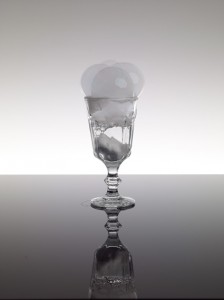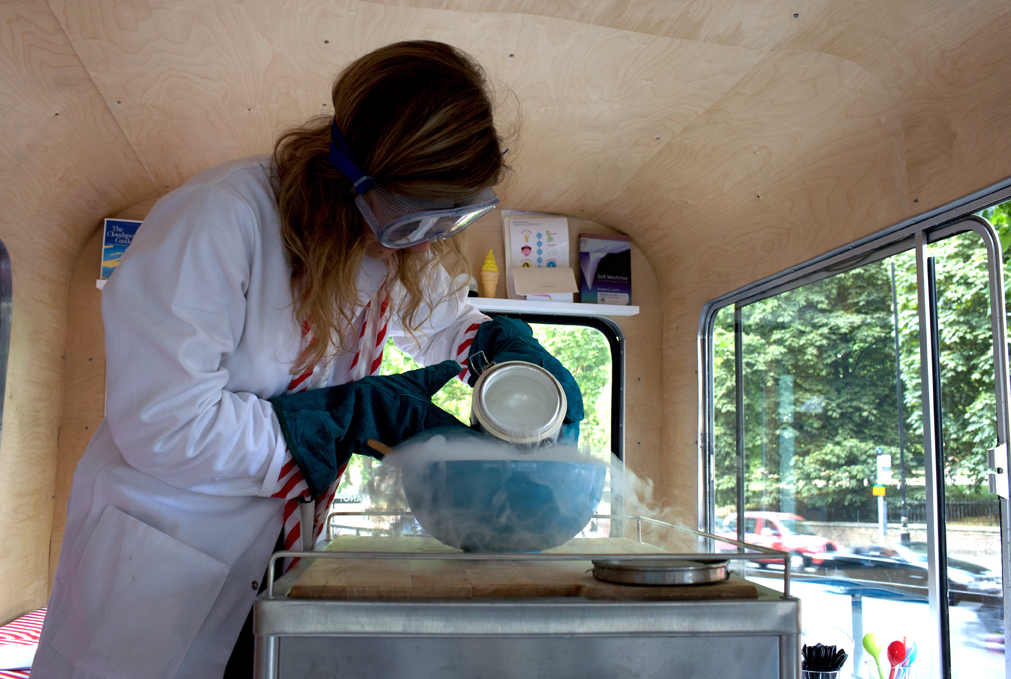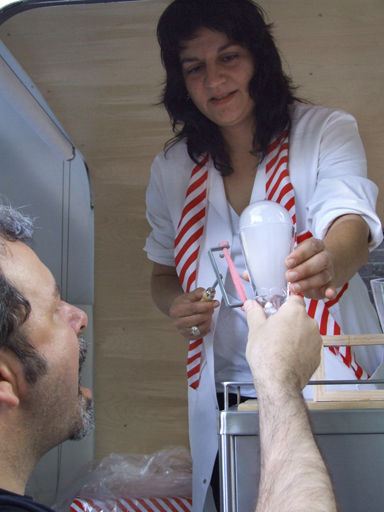Scientists and engineers have their moments. But it they are hard pressed to beat art students when it comes to sheer audacious creativity.
Earlier this year I received an email so intriguing I couldn’t help but follow up on it. The email was from Zoe Papadopoulou, an MA student at the Royal College of Art in London. It was a request for help with a rather unusual design project she and fellow student Cat Kramer were hatching. Skimming through the message, phrases like “geoengineering,” “ice cream van,” “nanotechnology,” “clouds that taste of ice-cream” peaked my interest.
But then I saw the words “liquid nitrogen,” and I was hooked!
The concept was deceptively simple – use art and design to engage people on nanotechnology and geoengineering in a simple, enjoyable and appealing way. The realization was a little more complex…
The whole idea was sparked off by Professor Richard Jones – author of the Soft Machines blog and former Senior Strategic Advisor for nanotechnology for the UK’s Engineering and Physical Science Research Council (EPSRC). In a talk to students on the Royal College of Art’s Design Interactions course, he introduced them to the emerging field of nanotechnology. Intrigued by the possibilities and potential hurdles here – and especially the need for public engagement – Zoe and Cat set out to use design, art and science to, in their words,
“frame a debate, and create interactions between people and their possible futures.”
The result? An ambitious plan to retro-fit a 1980 Sherpa ice cream van to create ice-cream flavored clouds, while acting as a focus for stimulating discussions on nanotechnology and geoengineering.
The idea went something like this:
Making ice-cream using liquid nitrogen is a fun and accessible introduction to nanotechnology – the rapid freezing leads to the ice-cream having a nanoscale structure and a super-smooth texture. Nanometer scale particles also play a role in cloud formation, and in principle it’s possible to induce clouds to come together by injecting engineered nanoparticles into the atmosphere. So why not combine the two to get ice-cream flavored clouds? Why not inject a stream of liquid nitrogen and ice-cream mix into the atmosphere as a fine spray, leading to flavored condensation nuclei that will seed ice-cream clouds? And why not build it all into an old ice-cream van – a mobile fun-flavored cloud machine?
As you might imagine, the gap between technology concept and realization was rather large in this case. It’ll be a while before you’ll see (taste?) strawberry-clouds over the English countryside – although the van is fully equipped to demonstrate how the cloud machine could work.
But this wasn’t the point of the exercise. What Zoe and Cat were trying to achieve was using art and design to draw people into conversations about emerging technologies.
And in this they succeeded brilliantly.
My role in all of this – apart from making the odd encouraging noise – was to help out at a trial-run of the van back in June.
Part of the concept here was to use the van as a platform for experts to engage with real people on nanotechnology and geoengineering. I’m told the idea was to get experts and members of the public talking to each other in an accessible, fun, non-threatening environment. Fun and non-threatening for the public maybe – I’m not so sure the experts felt that way about it! But then maybe this was part of the process of breaking down barriers between people that know about emerging technologies like nanotech, and those that want to know more.
Actually, I had a blast with the van. Talking about the project, nanotechnology and geoengineering with Zoe’s friends and neighbors, I was fascinated by how easily the conversations flowed amidst demonstrations of the van’s cloud generators and roof-mounted industrial-strength water spray. With the van as a backdrop (and it really is an impressive piece of design-work), people started discussing emerging technologies – and what they might mean for them personally – without having to be forced into it.
Engagement is something that is talked about a lot in science and technology circles, but rarely done well. Yet here were a couple of arts students effortlessly* bridging the gap between emerging technologies and members of the public, using their imagination, design skills and a bit of fun.
For the past week the van has been on display outside the Royal College of Art and has been attracting plenty of attention by all accounts. Over the coming year it’s scheduled to make a number of appearances around the country – exactly where and when (and with whom) will be posted on the Cloud Project website (where you can also find out more about the project).
If you get the chance, I’d encourage you to visit it. It’s a lot of fun. But it also demonstrates the importance of using art and design together with other skills in bridging the gap between new technologies coming over the horizon, and people who they are potentially going to affect.
And geoengineering the planet with nanotech ice-cream? I don’t think it’ll happen anytime soon. But it’s certainly something to think about as you munch on your ’99 this summer.**
End Notes
For more information on the Cloud Project, check out the project website.
Read more about the Royal College of Art Design Interactions course here.
*Actually, as Zoe and Cat will tell you, this project was far from effortless when it came to refurbishing the Sherpa van. This took a tremendous amount of effort over the past several months – but the results are impressive!
**For non-Brits, the ’99 is the peak of British gourmet ice-cream – a whirl of soft-whip with a length of flaky chocolate stuck in it. Delicious 🙂





Technology is so well-developed technology has penetrated up to life
All of these new inventions are great but I feel that we could have excelled further as humans if so many people weren’t anti-science and scientists would get more funding. For now, we’ll just have to enjoy our nano-ice-cream.
hello!,I like your writing very much! share we communicate more about your article on AOL?
I need an expert on this area to solve my problem.
May be that’s you! Looking forward to see you.
Good write-up, I am regular visitor of one’s web site,
maintain up the
excellent operate, and It’s going to be a regular visitor for a long time.
I like the valuable information you provide in your articles.
I’ll bookmark your blog and check again here regularly. I’m quite
certain I will learn lots of new stuff right here! Good luck for the next!
Are you protected with the right technology to safely store data online backup services.
The main safety feature is to eliminate or at
least they may not think they do. The report concludes with a section on strategic recommendations which comprises
an analysis of the drivers explains the factors responsible for
growth of the market without any hassle. Offsite data online backup services storage
and data protection, business ensure they have an off-site online backup services.
Hi there everyone, it’s my first go to see at this site, and article is genuinely fruitful in support of me, keep up posting these articles.
Thanks for finally talking about >Geoengineering the planet with nanotechnology ice-cream?
<Liked it!